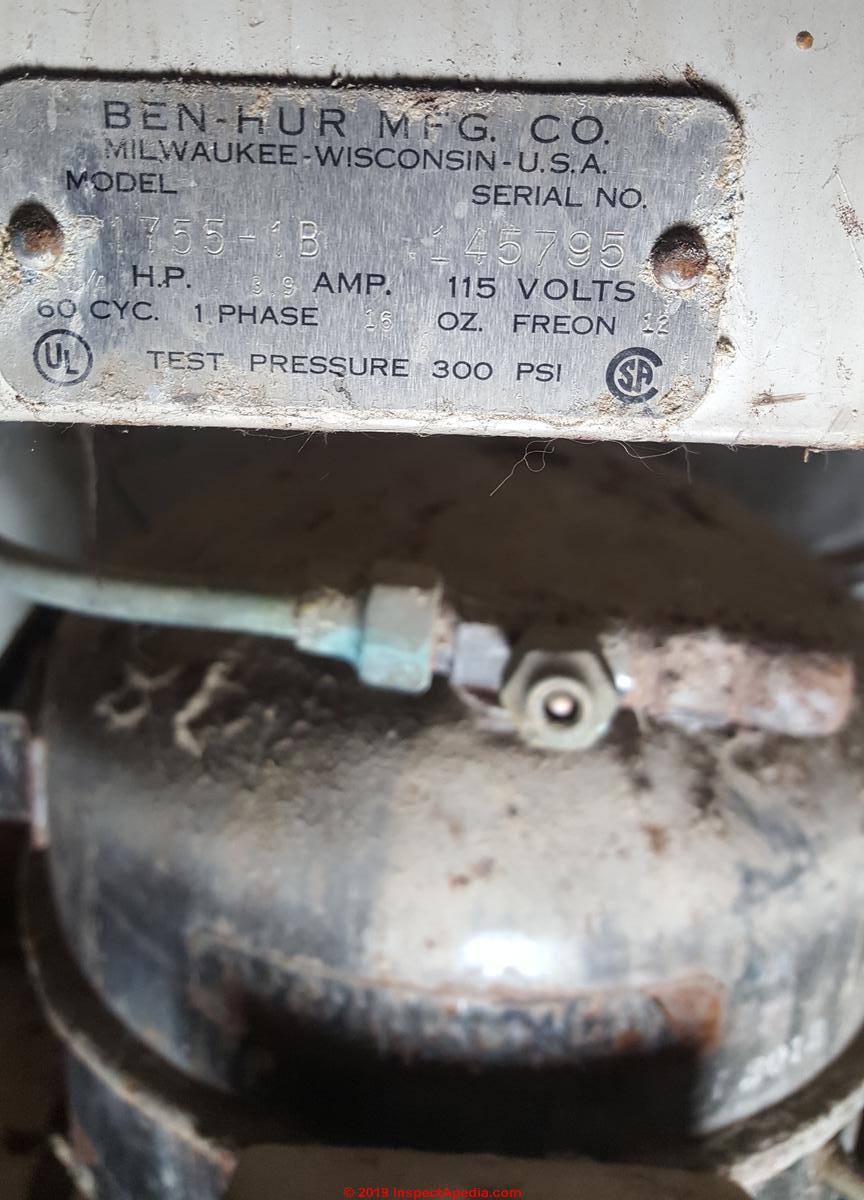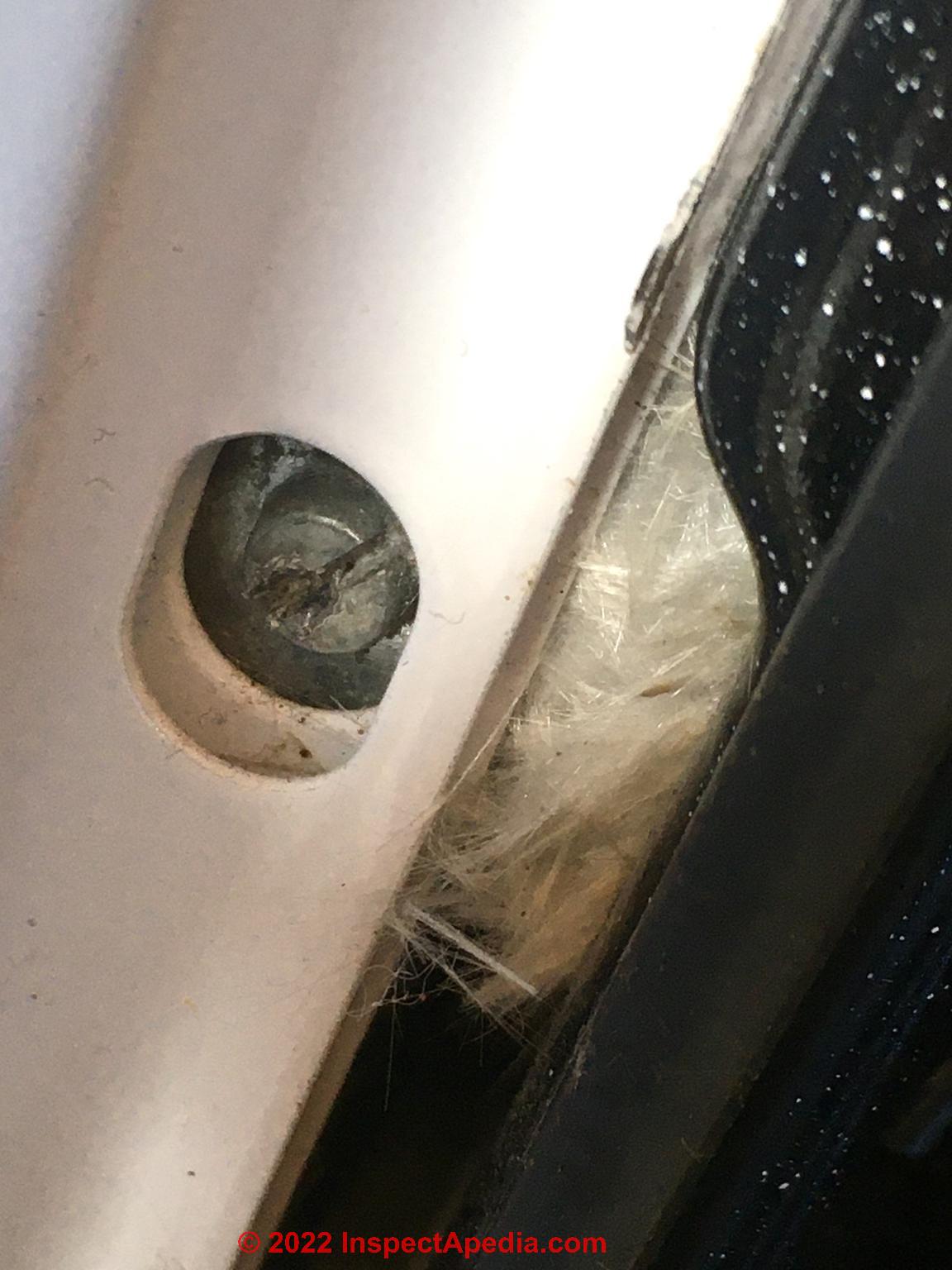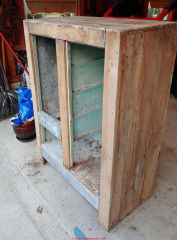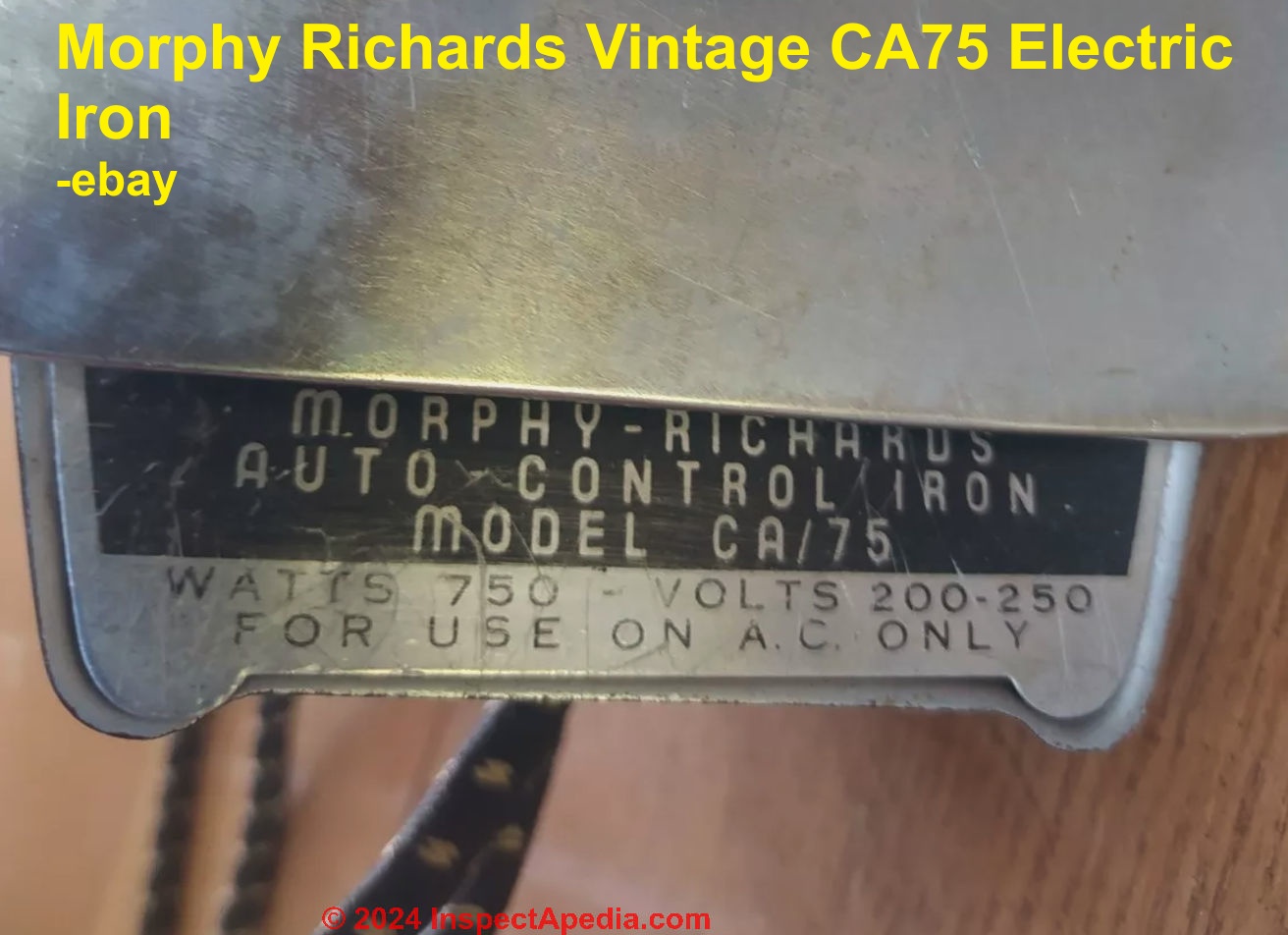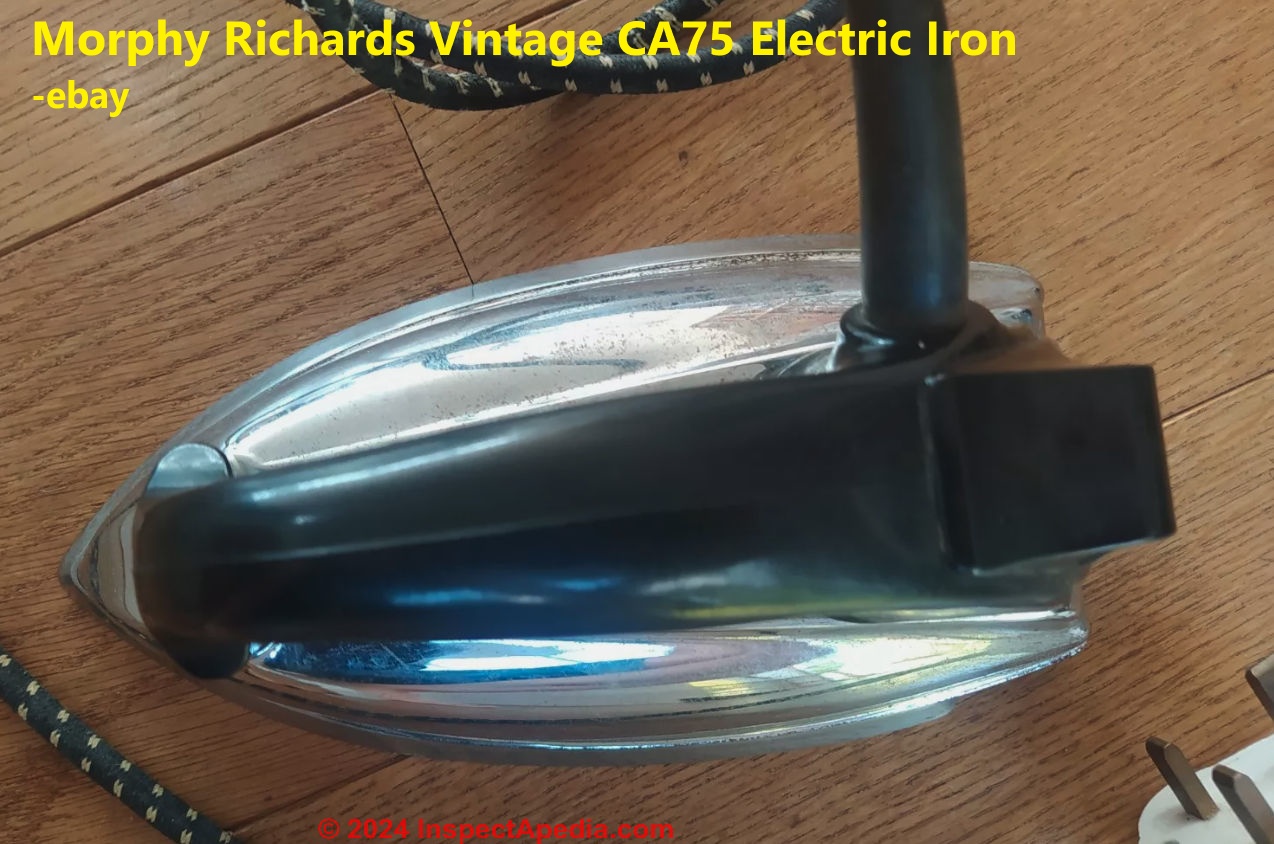 Asbestos Use in Appliances
Asbestos Use in Appliances
Asbestos contained in household appliances or appliance components
- POST a QUESTION or COMMENT about what building products and common in building products, appliances, mechanical components were produced using asbestos materials
Asbestos was used in some building & household appliances as gasket material, insulating material, or fire-proofing material.
Asbestos might be found in some household appliances such as clothes dryers, hair dryers, irons, toasters, ovens, and even refrigerators, though usually that asbestos is well covered and harmless.
Page top photo: a residential type clothes dryer investigated for asbestos content in gaskets or other components.
This article series provides a master list of the forms in which asbestos was used, a list of known asbestos-containing materials, and links to detailed articles about individual asbestos-containing products & materials found in buildings and in a wide range of products used in both home and industry.
InspectAPedia tolerates no conflicts of interest. We have no relationship with advertisers, products, or services discussed at this website.
- Daniel Friedman, Publisher/Editor/Author - See WHO ARE WE?
Use of Asbestos in Home Appliances
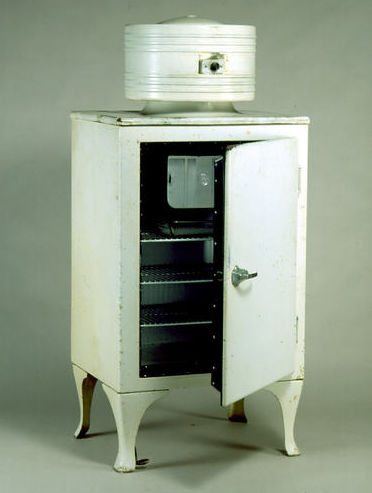 Here we list household appliances that might contain asbestos and we describe the forms in which asbestos might appear in appliances.
Here we list household appliances that might contain asbestos and we describe the forms in which asbestos might appear in appliances.
Asbestos was widely used in many gas & electrical appliances as a heat shield, as a gasket, as insulation, and sometimes as a structural component.
"As long as an appliance that contains asbestos is not broken or improperly used, it should be safe. With normal use, it is unlikely that the asbestos in these products will create a hazard.
Don’t attempt to repair any of these appliances yourself, take them to the manufacturer or dispose of them." - NJ Department of Health & Senior Services
Watch out: Don't panic about possible asbestos in a toaster, iron, or refrigerator. In most instances even when asbestos was used in a friable form it was enclosed within appliance walls or components.
Article Contents
- ASBESTOS in APPLIANCE DOOR GASKETS
- ASBESTOS in CLOTHES DRYERS - separate article
- ASBESTOS in REFRIGERATORS - door gaskets or wall / door insulation
- ASBESTOS in FREEZERS & ICE CHESTS
- ASBESTOS in TOASTERS / TOASTER OVENS - and toaster covers
- ASBESTOS in HAIR DRYERS - separate article
- ASBESTOS in IRONS & CURLING IRONS - separate article
- ASBESTOS in VENDING MACHINES - separate article
- ASBESTOS in OTHER SMALL APPLIANCES
- ASBESTOS in APPLIANCES - RESEARCH
The asbestos hazard from its presence in home appliances is likely to be below the limits of detection unless you disassemble and chop, grind, or saw these materials.
Asbestos may also appear in building or home appliances as a secondary product such as asbestos used in electrical wire insulation in toasters or irons, or in a high-temperature-resistant light bulb.
For products that have been left intact, not dis-assembled nor damaged, most appliances (hair dryers may be an exception) were not found to release enough asbestos that it was detected in air around the product when the product was in use.
Illustration: a 1927 GE Monitor Top refrigerator (Museums Victoria) that probably does not contain asbestos. [Click to enlarge any image]
Asbestos was used in these home appliances and possibly others that we will describe on this page: broilers, coffee pots, clothes dryers, coffee pots, in cookstoves (Moffatt and others), coolers, cooktops, deep fryers, dishwashers (possibly), ranges, refrigerators, irons & iron rests, toasters, electric heaters, ovens, popcorn poppers, vacuum cleaners, and washing machines.
Other household items used in the kitchen such as pot holders and some ironing board covers used asbestos fabrics.
...
Asbestos in Appliance Door Gaskets
Asbestos was used in some rope-type gaskets in some appliances. The last-use date for asbestos-containing gaskets will depend on the country where the appliance was manufactured or installed or both.
But in ordinary circumstances an asbestos-containing appliance door gasket that has remained undamaged should not produce a meaningful health hazard in the form of release of high levels of airborne asbestos.
This opinion is based on research articles cited include below.
Is a modern oven door gasket or white powder I see inside the oven an asbestos hazard?
First of all, congratulations for your work! Over the last few years, I have developed a completely irrational fear of asbestos due to suspicions I might have been exposed to it in the past. I now have OCD with this recurrent theme and my life has become harder.
I am writing today as I can not seem to find any information re: the dates at which asbestos stopped being used in ovens.
I have bought a condo and the oven and fridge were included with it so I kept them.
I am attaching a picture of the information in the oven door for your reference. In order to know if the oven has asbestos, I reached out to Frigidaire/Electrolux and their response was very evasive and anecdotal. I am thus reaching out to you to see if this oven contains asbestos.
I am worried because there is at times white powder in the oven when I cook with it. As I have brushed the oven with water and baking powder to clean it in the past, I suspect this is only that but the OCD has me doubting as always. I know this is irrational but it is also very suffering so I am reaching out for your help in reaching certainty.
Bottom line, I would like to know if my oven contains asbestos and, more generally, when we can know for sure appliances stopped having asbestos in them. Finally, when old appliances have asbestos, may you please tell me in which form/parts it is?
I am located in Montreal, Quebec, Canada if this makes a difference (asbestos was only fully banned in 2018 as I am sure you know) - Anonymous 2024/11/25
Answer: Asbestos from an oven door gasket is not likely to present a measurable asbestos exposure hazard
I'm not surprised that the manufacturer isn't going to give a clear answer to asbestos questions - their lawyers and their fear of litigation get in the way of, in my OPINION, even half-way reasonable service to their customers.
One cannot know, either, about asbestos content in both oven wall insulation (not visible, not accessible, not a hazard nor a question unless you're demolishing and disassembling the entire appliance) and in the oven door gasket.
When I researched the use of asbestos in modern appliance gaskets I found that because there are some exceptions in some countries, even today, we can't say with certainty that an appliance that has not been tested is absolutely asbestos-free.
But my OPINION is that regardless of its make-up, an oven door gasket wouldn't be likely to explain white deposits inside of an oven and in ordinary use would not be a detectable indoor airborne asbestos hazard in a residential property.
Bottom line
My opinion is that there is no meaningful health risk from the oven door gasket at your oven as you described it, and provided the appliance is kept intact.
Consider that worry about items like this may be a health concern of its own, so do what you can to rest easy.
Recommended Action
Try a simple spray cleaner, even glass cleaner, on cool oven surfaces to wipe off any such deposits if you can.
Don't take the oven apart nor chop, grind or saw the gasket. If you avoid such actions, even if the gasket did contain asbestos you're not making airborne dust of its contents.
Where to find more information about your appliance age
You can put some boundaries on the possible dates of manufacture of your oven by noting contextual information such as:
- The date of construction of the building where it was installed?
- The date the appliance was purchased if you can find invoices or bills of sale - from the oven door label we know at the very least that this oven was manufactured in or after 2008.
- The age of the actual oven appliance if the oven manufacturer will tell you that from its serial number?
In your case the oven door label identifies Electrolux Home Products, Electrolux Canada Corp., Cambridge Ont H3H 2N7 Canada
Research on Asbestos in Appliance Door Gaskets & Similar Products
Although they were not looking specifically at oven door gaskets that might contain asbestos, this study supports that opinion
- Garcia, Ediberto, Daniel Newfang, Jayme P. Coyle, Charles L. Blake, John W. Spencer, Leonard G. Burrelli, Giffe T. Johnson, and Raymond D. Harbison. "Evaluation of airborne asbestos exposure from routine handling of asbestos-containing wire gauze pads in the research laboratory." Regulatory Toxicology and Pharmacology 96 (2018): 135-141.
Other research into asbestos exposure from working with asbestos-containing gaskets or "asbestos gaskets" looked at potential exposure levels significantly greater than your oven door could present and did not report asbestos exposure levels that could possibly tell you to worry about your oven. For example:
- Mangold, Carl, Katherine Clark, Amy Madl, and Dennis Paustenbach. "An exposure study of bystanders and workers during the installation and removal of asbestos gaskets and packing." Journal of occupational and environmental hygiene 3, no. 2 (2006): 87-98.
Abstract excerpt: The results indicate that the 8-hour time-weighted average (TWA) exposures of pipefitters and other tradesmen who performed these activities were below the current PEL and all previous PELs. - Madl, Amy K., Katherine Clark, and Dennis J. Paustenbach. "Exposure to airborne asbestos during removal and installation of gaskets and packings: a review of published and unpublished studies." Journal of Toxicology and Environmental Health, Part B 10, no. 4 (2007): 259-286.
Abstract excerpt: In all but one of the studies relating to the replacement of gaskets and packing using hand-held tools, the short-term average exposures were less than the current 30-min OSHA excursion limit of 1 fiber per cubic centimeter (f/cc) and all of the long-term average exposures were less than the current 8-h permissible exposure limit time-weighted average (PEL-TWA) of 0.1 f/cc.
The weight of evidence indicates that the use of hand tools and hand-operated power tools to remove or install gaskets or packing as performed by pipefitters or other tradesmen in nearly all plausible situations would not have produced airborne concentrations in excess of contemporaneous regulatory levels.
...
Asbestos Uses in Refrigerators
Above: patent discussing use of asbestos in refrigerator gaskets. [Click to enlarge any image]
Reader Question: Did the old 1927 GE Monitor top refrigerator have asbestos? - Alyssa 2018/03/11
Reply: Asbestos was not found mentioned in patent research for the 1927 GE Monitor Top refrigerator - illustrated above on this page.
 Possibly, but my research did not find any mention of asbestos in the description of the GE monitor-top refrigerators.
Possibly, but my research did not find any mention of asbestos in the description of the GE monitor-top refrigerators.
The GE Monitor Top refrigerator was a major product development for General Electric and was widely sold and is still recognized world-wide.
I searched particularly for refrigerator insulation and for refrigerator gaskets and gasket patents associated with GE from 1925 - 1930 to see if those mentioned use of asbestos and did not find that indicator.
- Givens, Albert L. "Refrigerator." U.S. Patent 1,533,646, issued April 14, 1925. Original Assignee General Electric Co
- Griffiths, Richard T. "Packing gasket and method of making same." U.S. Patent 1,705,455, issued March 12, 1929.
- Sywert, Philip T. "Gasket." U.S. Patent 1,694,291, issued December 4, 1928. (I include an image from this patent)
Asbestos could also have been used as a refrigerator body or door insulating material, though I did not find that either (yet - I'm still researching).
Other patents from the same era such as Carrey (1930) do cite use of asbestos in the refrigerator construction.
- Carrey, John O. "Vacuous refrigerator and method of maintaining vacuum therein." U.S. Patent 1,747,969, issued February 18, 1930. Original Assignee C & C Engineering Company Inc.
Excerpt:
A U-shaped strip 24 of heat non-conducting material such as asbestos is placed over the bent edge 20 and a thin sheet 25 of lead is then placed over the U-shaped strip 24 and the whole is then forced into the pocket 23, and the assembled joint has the lead covering 25 bearing against the inner face of rebent edge 21 and the edge from edge 21 by asbestos covering 24.
Also Ballew (1925) describes use of asbestos in the refrigerator doors:
- Ballew, Neual W. "Vacuum-insulated container." U.S. Patent 1,561,769, issued November 17, 1925.
Excerpt:
The inner shells each contact with the outer shell only over a small surface at its front end. - The doors 4:, where they contact with the outer shell may be lined with a suitable heat insulating material, such as cork or asbestos, not shown.
...
Asbestos in Freezers & Ice Chests
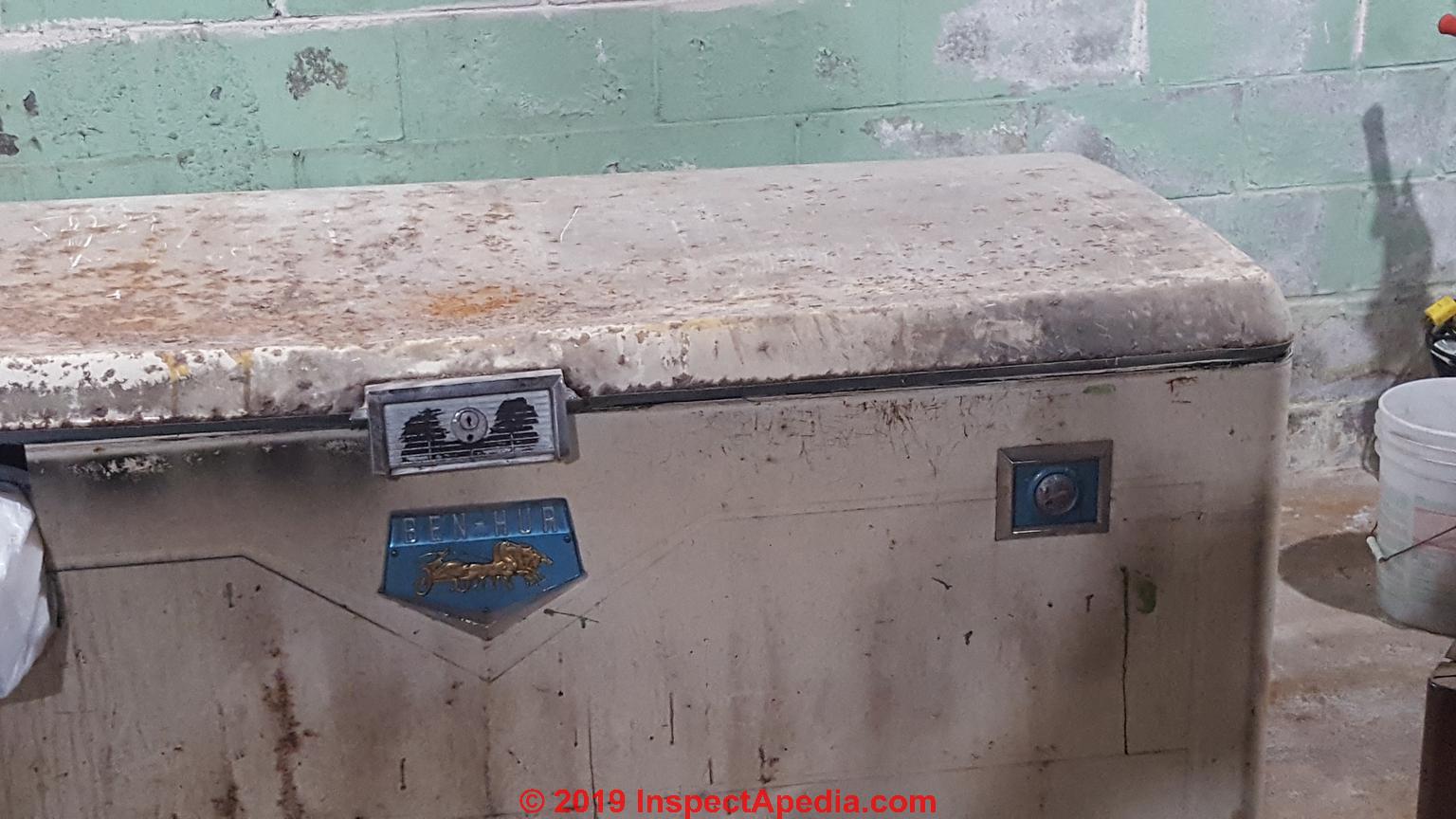 Asbestos in a1950s Ben Hur Ice Chest
Asbestos in a1950s Ben Hur Ice Chest
We have an old Ben Hur chest freezer from the 50s. Do these appliances contain asbestos? - On 2020-02-10 by Sara
Reply by (mod) -
Sara,
Thank you for the.Ben Hur freezer asbestos question.
I don't know that specific brand and if you can give me photos of the logo of the chest and of any data tags, it would help me research its history for a more definitive answer to the asbestos question. You can post one photo per comment.
The place where it's possible to see asbestos-suspect materials on a freezer would be at the door gaskets.
It's possible that asbestos was used as insulating material, but most likely that would be sealed inside the metal walls of the freezer chest. You can't see that and it's harmless as long as you're not chopping the old ice chest apart.
Confirm that the insulation in this Ben Hur Freezer is fiberglass, not asbestos
Material in question. Looks like Fiberglass but not sure because of the age of this unit - On 2020-02-11 by Chuck Beams
Reply by (mod) -
Chuck that is almost certainly fiberglass.
We have not found any authoritative sources confirming the mixture of asbestos directly with fiberglass insulating batts or insulating blankets though asbestos paper was found on some mineral wool or rock-wool insluation batts or "blankets".
The most-common building (and perhaps appliance) insulating material that might contain asbestos is Vermiculite.
See VERMICULITE INSULATION - home - for details.
The other common uses of asbestos in appliances included
- Asbestos-rope gaskets - ASBESTOS PACKINGS & GASKETS
- Asbestos-electrical wire insulation - on appliances where heat was a concern, such as electric irons and some stove top igniters
ASBESTOS ELECTRICAL WIRE INSULATION
Where to find out about Ben Hur Freezers & the Ben-Hur Manufacturing Company
Do you know of a way I can get documentation on this Freezer or contact email, phone # . Does some else now own what use to be Ben Hur Manufacturing.
There has to be some trail left behind I would think just for the fact of the possibility that asbestos could have been used in appliances dating back to this time. From my understanding some fiberglass insulation was manufactured with asbestos as an ingredient.
Also is there a way to positively test the material to assure that we are safe and I can confidently dispose of the unit once I cut it up and get it out of the basement and who would be best suited to handle this for disposal.
Sorry for all the question answer stuff but I want to be absolutely safe not only for the occupants in the home but for environmental aspect. Thanks again for your help. On 2020-02-11 by Chuck Beams -
Reply by (mod) - Patent numbers can put approximate date on old appliances
Are there any patent numbers?
Followup by Chuck Beams
I don't see Patent numbers at all just this plate with model and serial info.
Also have a picture of the material in question as I did a small cut away to view it.
Freezer is Ben Hur Model 1755 -B Serial # 145795.
Reply by (mod) - History of the Ben Hur Manufacturing Co. & Ben Hur Freezers
 Asbestos is not an ingredient if fiberglass insulation; they are separate materials;
Asbestos is not an ingredient if fiberglass insulation; they are separate materials;
There can, of course, be cross-contamination among materials depending on where they were manufactured, stored, used, etc.
You can certainly send a sample of your suspect material to a certified asbestos test lab.
In the ARTICLE INDEX given above you'll find an ASBESTOS TEST LAB LIST
More on the history of Ben Hur Freezers is found in some of the company's patent disclosures
Anderson, Leland J., and Stoner Charles Ward. "Combination freezer and dehumidifier." U.S. Patent 2,865,181, issued December 23, 1958. Application filed by Ben Hur Mfg Company
Donnelly, Daniel W. "Insulated wall construction." U.S. Patent 2,986,301, issued May 30, 1961. Application filed by Ben Hur Mfg Company
See inspectapedia.com/Appliances/Ben-Hur-Freezer-Patent-US2986301.pdf - this patent discusses freezer chest insulation - the word "asbestos" does not appear.
Followup Chuck Beams - asbestos was a possible insulating material in old freezers
Thank you so much for your hard work to find this information for me.
Although it does not specifically state which insulating material they used to pack the walls with, I would hope the material is not asbestos.
Another question would be is, would asbestos not be one of the options they employed in construction, and I quote "any desired type of heating insulation material" as stated in this patent at the time when these units were being constructed.
Reply by (mod)
Yes
...
Asbestos in Toasters & Toaster Covers
 Asbestos was widely used in toasters in several forms including electrical wire insulation, toaster side insulation, and heating element carriers from about 1910 through the 1970's and in some toaster appliances even into the mid 1980's.
Asbestos was widely used in toasters in several forms including electrical wire insulation, toaster side insulation, and heating element carriers from about 1910 through the 1970's and in some toaster appliances even into the mid 1980's.
Asbestos was also used in toaster covers (Landry 1981).
Butler (1903) patented a hand-held bread toaster (not-electric) that used or might use asbestos as one of the early U.S. patents citing use of asbestos in toasters.
Asbestos was still being used in toaster appliances in 1982 (Zim 1982) and is described in baking and frying appliances in 1984 (Matz 1984).
- Anderson, Roy J. "Electric toaster." U.S. Patent 2,548,511, issued April 10, 1951.
- Barton, Ruth. "Household technology in Western Australia 1900-1950." Oral History Association of Australia Journal, The 7 (1985): 108.
Excerpt:
In East Fremantle, about 1910, they heated their iron on a flat piece of asbestos laid over the top of a primus stove rather than on ...
See details at ASBESTOS PRODUCTS in AUSTRALIA - Butler, Louis F. "Bread-toaster." U.S. Patent 743,688, issued November 10, 1903.
Excerpt:
This invention relates to the class of breadtoasters in which a wire-netting or analogous open-work metallic sheet is superposed upon a heat-transmitting plate of asbestos or other suitable fireproof material. - Christoph, E.A., "Electric Toaster", U.S. Patent 1,393,427 , issued 10/11/1921
Cites use of asbestos in the supporting board for heating elements in the toaster. - Clark, Newman S. "Toaster." U.S. Patent 888,960, issued May 26, 1908.
Excerpt:
In the preparation of my device, I make a mixture composed of about 50 parts of fire-clay, 25 parts of clean sharp sand, 10 parts of asbestos, and 15 parts of wheat bran. This mixture properly moistened and adherent may be formed in molds into disks or plates of any suitable description. - Hirshfeld, Harry A., and Allan G. Stern. "Electric toaster." U.S. Patent 1,645,327, issued October 11, 1927. [Illustrated here]
Excerpt:
... waste asbestos board may be employed, and these parts shall be hereinafter referred to as asbestos boards or sheets, although not limited to i this material.
The supporting parts for the above described base are formed of wire. each support comprising asingle piece. of wire bent to form a horizontal, laterally extended top part 4
having vertical portions 5, bent at 6 to engage around the strip 3 and thereafter bent downwardly and upwardly to form legs 7
It will be understood that these supports may be detached, for packing purposes, so as to reduce the bulk of the device. Arranged in the same horizontal plane with the top parts 4 of said supports are other horizontally arranged, laterally extended wires 8 having vertical partis 9 and parts 10 bent around the strips 3.V
The end wires and intermediate wires are used to receive, for instance, bread and the like vto be toasted, the edible being supportedqby said wires free of the heating element. The heating element, which 1s designated 12, is supported by hook-like parts 13 of staples 14.
The staples 13 pierce the uppermost asbestos sheet or plate, are extended horizontally thereunder, as at 14', are passed up through said upper sheet of asbestos, and are clamped over the top surface of said upper asbestos sheet. - Hall, T., "Bread or Other Toaster", U.S. Patent 689,182, issued December 17, 1901 - cites use of asbestos in the parts of this non-electric toaster.
- Landry, Jean-Guy. "Cover for use on a toaster." U.S. Patent 4,254,695, issued March 10, 1981.
Excerpt:
The cover is preferably made of two layers of metal 26 and 28 and a layer of heat-insulating material 30, such as asbestos, is sandwiched between the two layers 26 and 28 at the top of its embossed portion. - Lemaster, Charles A. "Toaster." U.S. Patent 1,661,294, issued March 6, 1928. - Cites use of asbestos in the supporting board for heating elements in the toaster.
- Matz, Samuel A. "Equipment for Frying, Baking, and Drying." In Snack Food Technology, pp. 231-250. Springer, Dordrecht, 1984.
Excerpt:
Sheet material composed essentially of asbestos fibers and binders can be used as both insulation and a structural component. In this case, an outer covering is not necessary … FIG. 18.2. Toaster oven. - Snyder, Paul V. "Electric toaster heating unit." U.S. Patent 3,283,128, issued November 1, 1966.
Excerpt:
In perhaps its simplest form, the heating unit of the invention includes a relatively stiff resistance heating wire formed into a sinous series of loops which are secured at -their ends to an elongated support strip of insulation material such as asbestos. - Zirn, Rudolf F., and Erich Karlsen. "Insulating container for cooking food." U.S. Patent 4,323,167, issued April 6, 1982.
Excerpt: This disc 9 may be made of asbestos, rubber, glass fiber reinforced plastic or like heat-resistant and inexpensive material.
...
Asbestos in Hair Dryers
Information on asbestos use in hair dryers is now found
Asbestos in Clothing Irons & Hair Curling Irons
Information on asbestos use in clothing irons and curling irons is now found
Asbestos in an Old Vending Machines, Insulation or Flash Guards
Information on asbestos use in vending machines is now found
...
Other Possible Sources of Asbestos Used Within Appliance Components
- Asbestos in Coffee Pots
Asbestos was used in electrical wire insulation and insulation in some electric coffee pots. - Asbestos in portable electric heaters
Asbestos was widely used to carry electric heating elements, in heat-resistant wiring, and possibly in other components in electric heaters manufactured (in the U.S.) up to 1974. - Asbestos in large vs small Appliances - research
Hwang, Sung Ho, and Wha Me Park. "EVALUATION OF ASBESTOS-CONTAINING PRODUCTS AND RELEASED FIBERS IN HOME APPLIANCES." [PDF] Journal of the Air & Waste Management Association 66, no. 9 (2016): 922-929.
Abstract: The purpose of this study was to detect asbestos-containing products and released asbestos fibers from home appliances. The authors investigated a total of 414 appliances manufactured between 1986 and 2007. Appliances were divided into three categories: large-sized electric appliances, small-sized electric appliances, and household items.
Analysis for asbestos-containing material (ACM) was performed using polarized light microscopy (PLM) and stereoscopic microscopy.
Air sampling was performed to measure airborne concentration of asbestos using a phase-contrast microscope (PCM).
The results of the analysis for ACM in appliances show that large-sized electric appliances (refrigerators, washing machines, kimchi-refrigerators) and household items (bicycles, motorcycles, gas boilers) contain asbestos material and small-sized electric appliances do not contain asbestos material.
All appliances with detected asbestos material showed typical characteristics of chrysotile (7–50%) and tremolite (7–10%). No released fibers of ACM were detected from the tested appliances when the appliances were operating.
This study gives the basic information on asbestos risk to people who use home appliances.
Implications: All appliances with detected asbestos material showed typical characteristics of chrysotile (7–50%) and tremolite (7–10%).
No released fibers of ACM were detected from the tested appliances when the appliances were operating. - Asbestos in Electric Motors: Asbestos Compound for encasing motor windings -
see ASBESTOS ELECTRICAL WIRE INSULATION - Asbestos electrical wiring insulation -
see ASBESTOS ELECTRICAL WIRE INSULATION - Asbestos Fabrics & Textiles & Cloth -
see ASBESTOS TEXTILES - Asbestos Felt was used in products such as acoustical liners, noise insulation, adhesives, plastics.
The properties of asbestos felts are described in table 9.2 found
at ASBESTOS in PLASTICS - Asbestos in Filters are discussed in detail
at ASBESTOS FILTERS - Asbestos in appliance insulation - possibly,
see ASBESTOS INSULATION - Asbestos in light bulbs, Light bulbs, lamps, room deodorizers & fragrance dispensers are discussed
at LIGHT BULB ASBESTOS USE
Our complete list of products and materials that made use of asbestos is found
Note that asbestos may be present in still other substances and even products, not by its deliberate use or design, but because it occurs naturally, such as asbestos that is found in some talc powders (amphibole asbestos).
CONTACT US to add items and photographs to this list of asbestos containing materials used in or on appliances.
...
Asbestos in Appliances, Research
- Hwang, Sung Ho, and Wha Me Park. EVALUATION of ASBESTOS-CONTAINING PRODUCTS & RELEASED FIBERS in HOME APPLIANCES [PDF] Journal of the Air & Waste Management Association, Volume 66, 2016 - Issue 9: A Special Issue of JA&WMA on NOAA's 7th International Workshop on Air Quality Forecasting Research (IWAQFR)
Abstract:
The purpose of this study was to detect asbestos-containing products and released asbestos fibers from home appliances. The authors investigated a total of 414 appliances manufactured between 1986 and 2007.
Appliances were divided into three categories: large-sized electric appliances, small-sized electric appliances, and household items. Analysis for asbestos-containing material (ACM) was performed using polarized light microscopy (PLM) and stereoscopic microscopy. Air sampling was performed to measure airborne concentration of asbestos using a phase-contrast microscope (PCM).
The results of the analysis for ACM in appliances show that large-sized electric appliances (refrigerators, washing machines, kimchi-refrigerators) and household items (bicycles, motorcycles, gas boilers) contain asbestos material and small-sized electric appliances do not contain asbestos material.
All appliances with detected asbestos material showed typical characteristics of chrysotile (7–50%) and tremolite (7–10%).
No released fibers of ACM were detected from the tested appliances when the appliances were operating.
This study gives the basic information on asbestos risk to people who use home appliances.
Implications: All appliances with detected asbestos material showed typical characteristics of chrysotile (7–50%) and tremolite (7–10%). No released fibers of ACM were detected from the tested appliances when the appliances were operating.|
Excerpt:
… In this study, asbestos was not detected in the air around the asbestos-containing products when the products were in use, because ACM was firmly seated in the inner parts of the … - New Jersey, ASBESTOS, A GUIDE for NEW JERSEY RESIDENTS [PDF], NJ Department of Health & Senior Services, Consumer, Environmental & Occupational Health Service Indoor Environments Program PO Box 369 Trenton, NJ 08625-0369 Phone: 609-826-4950 Fax: 609-826-4975 state.nj.us/health/iep - retrieved 2023/05/06, original source: rucore.libraries.rutgers.edu
"As long as an appliance that contains asbestos is not broken or improperly used, it should be safe. With normal use, it is unlikely that the asbestos in these products will create a hazard.
Don’t attempt to repair any of these appliances yourself, take them to the manufacturer or dispose of them."
...
Reader Comments, Questions & Answers About The Article Above
Below you will find questions and answers previously posted on this page at its page bottom reader comment box.
Reader Q&A - also see RECOMMENDED ARTICLES & FAQs
Asbestos in Australian boat refrigerator?
I have a boat built in 1953 in Australia that has a refrigerator in it. I need to cut holes in the walls of the fridge and wonder if there could be asbestos insulation behind the walls. Is it possible that asbestos was used to insulate marine fridges from this period? On 2022-12-07 by Mark caulfield -
Reply by InspectApedia (Editor) - possibly, encapsulated (safe) inside the refrigerator walls -
@Mark caulfield,
A 1953 refrigerator made in Australia might contain asbestos and insulation and conceivably in a door gasket.Watch out: don't go drilling into the walls of an old refrigerator that could have been insulated with asbestos without having a representative insulation sample tested for asbestos - OR - treat the material as PACM - Presumed Asbestos Containing Material to be safe.
You can only post one photo per comment but you can use as many comments as you need.
Asbestos in a 1980's GE Electric Clock-Radio
Would asbestos have been used in a General Electric alarm clock radio from the 80s? Thanks! On 2022-11-03 by Anonymous -
Reply by InspectApedia (Editor) - asbestos in General Electric alarm clock radio from the 80s
@Anonymous,
Possibly as an internal heat shield if the radio uses tubes otherwise it seems unlikely
Asbestos in Brother microwave/oven combo insulation?
We have a very old Brother combination oven (i.e.microwave/convection oven). My husband took the back off it yesterday and it revealed some fibrous insulating material.
Could this be asbestos? We think the combination oven may be around 30 years old, maybe even older. - On 2022-01-09 by Stephanie Robinson -
Reply by Inspectapedia Com Moderator - look for fiberglass
@Stephanie Robinson,
Possible but unlikely; one cannot say whether or not your oven insulation contains asbestos based just on a text message.
A photo would be helpful.
Most likely you're looking at fiberglass.
Asbestos in an Oven Insulation?
Hi there!
Second time using your expertise! First was regarding possible asbestos in insulation panels in a pre-fab Russian house imported to northern Italy.
This time we have an oven in an apartment in Switzerland that has started moulting!
On one side you can see this material that I presume is insulation. Is it asbestos or dangerous?
Many thanks in advance.
Mark - On 2021-08-18 by Mark -
Reply by inspectapedia.com.moderator - Fiberglass insulation in Swiss oven
@Mark,
I remember the Russian - Italian house - that was pretty special.
About your photo: I see what looks like it is almost certainly fiberglass insulation.Followup by Mark
@inspectapedia.com.moderator,
Many thanks once again for your quick reply and for sharing your knowledge of such things.
Mark
Is there asbestos in the parts of my PC (Personal Computer)?
Do PC (computer) parts contain abestos On 2020-03-11 by steven -
Reply by danjoefriedman (mod)
Asbestos used inside of a personal computer would be entirely unlikely unless you have an antique piece of equipment built before the mid-1980s
Asbestos in a 1960's GE Oven Light Fixture
Does an oven light gasket from a 1960's GE in wall oven contain absbestos? It is a gray felt like material. On 2019-12-30 by Matthew -
Reply by (mod) -
Its possible but it should be pretty easy to make an educated guess by simply looking at the material: some alternatives like fiberglass or cotton felt are usually easily identified by the nakedeye.
In all events, an oven light gasket won't present a detectable asbestos hazard in your building unless you grind it up.
On 2019-08-11 by Sherry Noland - Asbestos insulation in antique ice box ?
I have a 1900's icebox. I removed the exterior metal pieces to expose the wood, but did not mess with the insulated doors.
Could I have been exposed to asbestos? Is it safe to stain and repaint to put in my home?
Reply by (mod) - safe to use an antique ice box if you're not disassembling it
Sherry
No one can make a scientifically sound assessment of asbestos exposure from an e-text: we don't know if asbestos was present, in what form, nor how much, if at all, it was disturbed.
However as a general remark, if you removed and disposed of insulated doors that were intact then it's not likely that you were exposed to detectable amounts of whatever insulation was involved.
On 2019-03-11 by Mag - asbestos in Morphy Richards Senior Iron Washers?
Did Murphy Richards senior iron have asbestos washers.
Reply by (mod) -
Mag
An interesting historical asbestos question. I don't know the answer.To find a credible authoritative answer to your question you would need to identify the manufacturer of the iron and then we might have success by doing a simple patent search.
Above we've included photos of a Morphy Richard CA75 Electric iron as advertised for sale on ebay. I don't see any accessible washers. It would also be helpful to know the estimated age of the iron and also if you can confirm that your Morphy Richard iron was made or used outside of the UK.
On 2018-09-10 by dh - asbestos in a 1970 Corning cooktop
does a 1970 corning cooktop have asbestos insulation
Reply by (mod) -
Possibly as heat resistant insulation on electric wiring.
I can't rule out other insulation but I have no record of it.
On 2018-05-21 by Barb - Was asbestos used in old wood fired cook stoves
Where was asbestos used in the old wood cook stoves? I have a 1909 Enterprise Majestic Wood Cookstove that I want to refurbish and would like to know before I start what I can expect to find.
Reply by (mod) ) - 1909 Enterprise Majestic Wood Cookstove asbestos
Barb
If asbestos is found in old wood stoves, including wood stoves used for cooling, I'd expect it to appear as an ingredient in stove cement between stove sections (used to stop air leaks and thus to permit control of stove draft), and possibly on some later stoves as an asbestos rope gasket.
Show us a photo of your stove and closeups of suspect gaskets and sealants as those would be instructive.
To know for certain about a 100+ year old material you'd need to have a sample tested - or simply treat it as PACM - presumed asbestos containing material.
ASBESTOS TESTING LAB LIST is there if you need it
On 2018-05-01 by Pat - Asbestos in a 1960s or 1970s Kenmore Freezer?
Is their asbestos in a 1969 or 1970 kenmore freezer. I need to chop it up and get rid of it as it will not fit up the stairs from the downstairs. Thank you in advance.
Reply by (mod) -
It's not likely. But I'm not sure how you're going to chop up a freezer. If you mean you're going to cut the metal sections apart. My suggestion would be at your first cut that you inspect the insulation. Most likely you'll find fiberglass.
Watch out: unless you can easily identify fiberglass you should avoid chopping or hacking any old appliance whose insulation could be asbestos.
...
Continue reading at ASBESTOS LIST of PRODUCTS - topic home, or select a topic from the closely-related articles below, or see the complete ARTICLE INDEX.
Or see these
Recommended Articles
- APPLIANCE DIAGNOSIS & REPAIR - home
- ASBESTOS USE in AIR CONDITIONERS
- ASBESTOS in CLOTHES DRYERS
- ASBESTOS in BLANKETS
- ASBESTOS ELECTRICAL WIRE INSULATION
- ASBESTOS in LAMPS & LIGHT BULBS
- ASBESTOS in UNUSUAL PLACES
- ASBESTOS IDENTIFICATION IN BUILDINGS
- ASBESTOS PHOTO GUIDE to MATERIALS - illustrations & photos of asbestos-containing materials
- ASBESTOS PRODUCTS BANNED vs PERMITTED U.S. 2023
- DOES THIS MATERIAL CONTAIN ASBESTOS? - 5 easy questions to tell if a BUILDING MATERIAL probably contains asbestos -
- HAZARD vs RISK - what's the difference, why you should care
Suggested citation for this web page
ASBESTOS USE in APPLIANCES at InspectApedia.com - online encyclopedia of building & environmental inspection, testing, diagnosis, repair, & problem prevention advice.
Or see this
INDEX to RELATED ARTICLES: ARTICLE INDEX to ASBESTOS HAZARDS
Or use the SEARCH BOX found below to Ask a Question or Search InspectApedia
Ask a Question or Search InspectApedia
Questions & answers or comments about what building products and common in-building products, appliances, mechanical components were produced using asbestos materials.
Try the search box just below, or if you prefer, post a question or comment in the Comments box below and we will respond promptly.
Search the InspectApedia website
Note: appearance of your Comment below may be delayed: if your comment contains an image, photograph, web link, or text that looks to the software as if it might be a web link, your posting will appear after it has been approved by a moderator. Apologies for the delay.
Only one image can be added per comment but you can post as many comments, and therefore images, as you like.
You will not receive a notification when a response to your question has been posted.
Please bookmark this page to make it easy for you to check back for our response.
IF above you see "Comment Form is loading comments..." then COMMENT BOX - countable.ca / bawkbox.com IS NOT WORKING.
In any case you are welcome to send an email directly to us at InspectApedia.com at editor@inspectApedia.com
We'll reply to you directly. Please help us help you by noting, in your email, the URL of the InspectApedia page where you wanted to comment.
Citations & References
In addition to any citations in the article above, a full list is available on request.
- 16 CFR Chapter 11, Consumer Products Containin Asbestos, Advance Notice of Proposed Rulemaking", [PDF] U.S. Consumer Products Safety Commission, CPSC, U.S. Federal Register, Vol. 44. No 201, 17 October 1979, Proposed Rules, 60057. This document cites a long list of consumer products that contained asbestos.
- Archer, S. R., and T. R. Blackwood. Status assessment of toxic chemicals: asbestos. Vol. 1. Environmental Protection Agency, Office of Research and Development, Industrial Environmental Research Laboratory, 1979. In this text, table 4. U.S. Asbestos Uses (3)
This book is available as a free e-book via Google Play. Link:
https://play.google.com/books/reader?id=U57ObCey-wcC&printsec=frontcover&output=reader&hl=en&pg=GBS.PP1 - ASBESTOS HISTORY & PROPERTIES [Book online] D.V. Roasato, engineering consultant, Newton MA, Reinhold Publishing Co., NY, 1959, Library of Congress Catalog No. 59-12535. We have re-published this text as an online book at InspectApedia. Excerpts & adaptations are also found in InspectApedia.com articles on asbestos history, production & visual identification in and on buildings.
- "Asbestos in Plastic Compositions", A.B. Cummins, Modern Plastics [un-dated, pre 1952]
- "Asbestos in Your Home," Spokane County Air Pollution Control Authority, Spokane WA 509-477-4727 www.scapa.org provides a one-page image, a .pdf file drawing of a house warning of some possible sources of asbestos in the home. The sources are not ranked according to actual risk of releasing hazardous levels of airborne asbestos fibers and the list is useful but incomplete.
- Chrysotile [asbestos] and Its Uses, Louis Perron, Minerals and Metals Sector, Canadian Minerals Yearbook, 2002, Natural Resources Canada, web search 03/01/2011, original source: http://www.nrcan-rncan.gc.ca/mms-smm/busi-indu/cmy-amc/content/2002/20.pdf
- The US EPA provides a sample list of asbestos containing products epa.gov/earth1r6/6pd/asbestos/asbmatl.htm
- Thanks to Susan Kimball, Argus Pacific Corp., Puget Sound, WA, for pointing out that some products are permitted to contain more than 1% asbestos fibers by current standards provided that the fibers are encapsulated in an appropriate binder. Argus Pacific, in Seattle, WA 98119, 206.285.3373, is an industrial hygiene firm who also provide OSHA and DOSH regulated training in Washington State, providing classes in asbestos, lead, mold, hazardous waste, emergency response, and other occupational health, safety, and professional development topics. -- September 2008.
- How do I Manage Asbestos in our House or Apartment Building?, Illinois Department of Environmental Conservation, provides this article at http://www.epa.state.il.us/small-business/asbestos-in-home/
- Asbestos in buildings - employee notice, University of Washington dept. of Environmental Safety, http://www.ehs.washington.edu/ohsasbestos/index.shtm
- ASBESTOS IN YOUR HOME U.S. EPA, Exposure Evaluation Division, Office of Toxic Substances, Office of Pesticides and Toxic Substances, U.S. Environmental Protection Agency, Washington,D.C. 20460 Division, Washington, DC 20460,original web source: http://www.epa.gov/region04/air/asbestos/awet.htm
- Asbestos products and their history and use in various building materials such as asphalt and vinyl flooring includes discussion which draws on ASBESTOS, ITS INDUSTRIAL APPLICATIONS, ROSATO 1959, D.V. Rosato, engineering consultant, Newton, MA, Reinhold Publishing, 1959 Library of Congress Catalog Card No.: 59-12535 (out of print, text and images available at InspectAPedia.com).
- EPA ASBESTOS MATERIALS BAN: CLARIFICATION 1999
- EPA Guidance for Controlling Asbestos-Containing Materials in buildings, NIAST, National Institute on Abatement Sciences & Technology, [republishing EPA public documents] 1985 ed., Exposure Evaluation Division, Office of Toxic Substances, Office of Pesticides and Toxic Substances, U.S. Environmental Protection Agency, Washington,D.C. 20460
- In addition to citations & references found in this article, see the research citations given at the end of the related articles found at our suggested
CONTINUE READING or RECOMMENDED ARTICLES.
- Carson, Dunlop & Associates Ltd., 120 Carlton Street Suite 407, Toronto ON M5A 4K2. Tel: (416) 964-9415 1-800-268-7070 Email: info@carsondunlop.com. Alan Carson is a past president of ASHI, the American Society of Home Inspectors.
Thanks to Alan Carson and Bob Dunlop, for permission for InspectAPedia to use text excerpts from The HOME REFERENCE BOOK - the Encyclopedia of Homes and to use illustrations from The ILLUSTRATED HOME .
Carson Dunlop Associates provides extensive home inspection education and report writing material. In gratitude we provide links to tsome Carson Dunlop Associates products and services.





